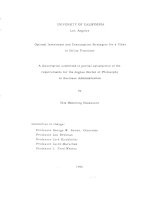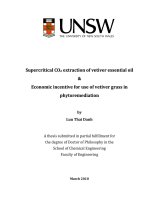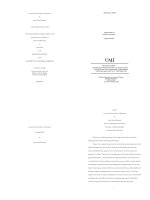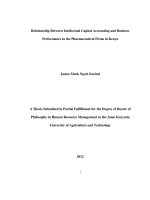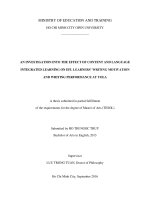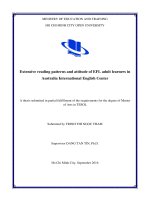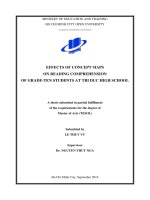a dissertation submitted ni partial fulfilment of the requirement of the degree of doctor of phylosocphy
Bạn đang xem bản rút gọn của tài liệu. Xem và tải ngay bản đầy đủ của tài liệu tại đây (872.39 KB, 205 trang )
Unanticipated Intertemporal Change
in Theories of Interest
by
Robert P. Murphy
A dissertation submitted in partial fulfillment
of the requirements for the degree of
Doctor of Philosophy
Department of Economics
New York University
May 2003
_____________________
Mario Rizzo
Dedicated to the memories of
Sir John Hicks
and
Friedrich Hayek.
ii
Acknowledgements
These essays were written over the course of several years, and are much clearer
because of the careful reading and helpful suggestions of Mario Rizzo, Alberto
Bisin, Boyan Jovanovic, John Leahy, and Andrew Caplin. I would also like to
thank Peter Lewin, Jeffrey Herbener, Paul Birch, Thomas McQuade, David Harper,
and Gene Callahan for the extensive comments they provided on early drafts of the
essays, and I would like to thank Israel Kirzner for his discussions on the pure time
preference theory.
Members of the NYU Austrian Colloquium also provided
helpful comments, as well as others whom I am surely forgetting.
I am grateful for the freedom I had to dwell on these matters in the laissez-faire
academic environment of the NYU Austrian fellowship.
The first essay was
written while I was a summer fellow at the Ludwig von Mises Institute in Auburn,
Alabama.
Finally I would like to thank my grandmother, Catherine Kelly, for providing me
with a place to stay, and my fiancée, Rachael, for tolerating my divided attention,
while I explored a topic that has been rightly called the “black hole of economics.”
iii
Preface
This book is a collection of three separate essays that I wrote while on the Austrian
fellowship at New York University. My interest in this area started when I had to
prepare a paper for the NYU Austrian Colloquium. Initially I wanted to work on
the Austrian business cycle theory, but I soon found that my dissatisfaction with the
Austrian approach to interest was such that I had to divert my attention to pure
capital and interest theory. I presented my (lengthy) paper, “Interest in the Austrian
Tradition,” to the Colloquium.
Much of the work in this book is merely an
elaboration of that original paper.
Although they were written as stand-alone essays, the essays should be read in
order, as the later ones build upon the earlier. (However, the reader who is able and
willing to read the mathematical appendix should probably do so immediately after
the first essay.) A central theme running throughout the papers is that economists
have traditionally paid insufficient attention to the problems of change, and in
particular unanticipated change, in their theories of interest.
The first essay introduces the impressive work on capital and interest theory by
Eugen von Böhm-Bawerk. In it I explain Böhm-Bawerk’s views and his celebrated
critique of what he called the naïve productivity theories of interest. As I read
iv
Böhm-Bawerk’s work for the first time, I slowly began to suspect the negative
verdict given him by the profession. I hope that my (qualified) defense of his work
will cause subsequent historians of economic thought to reevaluate his pioneering
contributions.
The second essay is a critique of the Austrian “pure time preference theory” of
interest. I claim that the Austrians focus too narrowly on one aspect of BöhmBawerk’s work, and have caused needless confusion in their writings. I further
argue that, ironically, the pure time preference theory is deficient on precisely those
criteria of economic theory that are quintessentially Austrian, such as heterogeneity
of goods, uncertainty of the future, and dynamic processes through time.
In the third essay I widen my focus. I claim that a fundamental problem with
Böhm-Bawerk’s theory was his aggregation of goods according to their date of
availability. This component of his work led to the modern “real” approach to
interest theory, which explains the premium on money loans as the outward
expression of the underlying intertemporal exchange of real commodities.
Drawing on the insights of the so-called “radical subjectivists,” I offer a completely
different explanation of interest rates, viewing them as purely monetary phenomena
reflecting the uncertainty of the future.
v
Finally, in a mathematical appendix I formalize Böhm-Bawerk’s arguments against
the naïve productivity theories. Using general equilibrium models, I show that the
standard one-good mainstream growth models completely overlook BöhmBawerk’s insights in this area.
This book is intended to address a gap in economics.
Somewhere between
common sense and calibrated models, there is a loose collection of principles that
help us judge the merits of any particular economic theory. I have dedicated the
book to John Hicks and Friedrich Hayek, for they were excellent role models for
the purpose I had chosen. In particular, their work was a constant reminder that
even metatheoretical musing can be rigorous, and indeed must be.
RPM
April, 2003
vi
Table of Contents
Dedication
ii
Acknowledgements
iii
Preface
iv
List of Tables
viii
Chapter One
A (Qualified) Defense of Böhm-Bawerk’s “Third Cause” of Interest
1
Chapter Two
Some Problems with the Pure Time Preference Theory of Interest
58
Chapter Three
A Monetary Approach to Interest Theory
127
Appendix
Dangers of the One-Good Model
178
References
191
vii
List of Tables
Table 1 Output of Labor in Processes of Various Durations
23
Table 2 Equilibrium Real Exchange Ratios
105
Table 3 Equilibrium Money Prices
106
Table 4 Umbrella Counterexample to Claim VI
112
Table 5 Equilibrium Real Exchange Ratios
131
viii
Chapter One
A (Qualified) Defense of Böhm-Bawerk’s
“Third Cause” of Interest
INTRODUCTION
In the late nineteenth century, Eugen von Böhm-Bawerk’s magisterial work (1959
[1889]) on capital and interest provided the foundation upon which virtually all
modern theories are built. In his first volume, History and Critique of Interest
Theories, Böhm-Bawerk classified and (in his mind) refuted all previous
explanations. Böhm-Bawerk thought a proper theory of interest must explain the
apparent undervaluation of future goods. For example, if a machine is expected to
yield annual rents of $1,000 for ten years, why does it sell now for less than
$10,000? To answer this question was to provide a theory of interest, for only with
such an undervaluation would it be possible for a capitalist to invest in machines
(for example) and reap a flow of returns (over time) greater than his initial
investment.
1
The naïve productivity theory
With the task of the interest theorist so formulated,1 Böhm-Bawerk found the
existing doctrines of his time to be inadequate.
In particular, Böhm-Bawerk
criticized what he termed the “naïve productivity theory” of interest. The naïve
productivity theory2 explained the net return earned by an investor, by reference to
the productivity of the capital goods in which he invests. For example, a farmer
might purchase a tractor for $8,000, even though it will last ten years and increase
his profits by $1,000 for each of those years. The twenty-five percent3 return on
the investment would be due (according to the naïve productivity theory) to the fact
that tractors are productive; more can be produced with a tractor than without one.
Böhm-Bawerk considered this reasoning to be completely fallacious, for it
conflated physical productivity with value productivity.
Yes, the physical
productivity of the tractor explains why more crops can be harvested with it than
without. But the tractor’s physical productivity does not (by itself) explain why the
value placed on the tractor (i.e. its price of $8,000) should be lower than the value
placed on its future products (i.e. the marginal revenue of $10,000). The net rate of
1
The specific problem was to explain, “Whence and why does the capitalist receive this endless and
effortless flow of wealth?” (I, p. 1, italics removed).
2
Actually, the “second variant” of naïve productivity theories, in Böhm-Bawerk’s classification; see
below.
3
In fact the return would be more than twenty-five percent, because of compounding. The rest of
the analysis disregards this complication, and assumes the farmer will have $10,000 when the
tractor is discarded.
2
interest (twenty-five percent in our example) does not correspond to the value of a
capital good’s services, but rather to the ratio of its value to the value of its
services.
Böhm-Bawerk’s agio theory
After criticizing his predecessors, Böhm-Bawerk offered his own explanation
(“agio theory”) in his second volume, Positive Theory of Capital. The “nub and
kernel” of his theory was the insight that, “Present goods are, as a rule, worth more
than future goods of equal quality and quantity” (II, p. 259). Böhm-Bawerk argued
that the market’s objective undervaluation of physically identical objects in the
future was due to individuals’ subjective undervaluations of these temporally
distant goods.
To return to our earlier example: The price of a tractor represents an opportunity
cost in present goods and services, and will only yield its returns in the future (over
the course of a decade).
If individuals subjectively value present goods and
services more than future ones, then it naturally follows that the price of a tractor
($8,000 in our example) will be lower than the total revenues ($10,000) it is
expected to generate. As such, an investment in tractors will yield a net financial
return over time, and it is this appreciation in market value—as future income
3
becomes transformed into more highly valued present income—that is the source
of “originary interest.”4
All forms of interest, including contract interest on
consumption loans, are manifestations of originary interest, and reflect a difference
in intertemporal utilities (and a corresponding difference in intertemporal market
prices).
Although elementary from a modern perspective, Böhm-Bawerk’s explanation was
the first to systematically apply the new insights of the marginal (and subjective)
revolution (e.g. Menger 1994 [1871]) to the problem of interest. However, as
Fetter pointed out, Böhm-Bawerk hadn’t really explained interest; he had just
formulated the problem in a more satisfactory manner. Yes, positive interest rates
could be viewed as equivalent to a subjective premium placed on present goods,
but why should such a premium exist at all?
Böhm-Bawerk’s three causes
To explain the existence of such a premium on present versus future goods, BöhmBawerk offered three main reasons.
First, in general people expect to grow
wealthier over time, and thus on that account (due to diminishing intratemporal
4
“Originary interest” is the term Böhm-Bawerk used to denote the surplus proceeds earned (over
time) by investment in capital goods (I, p. 6). Originary interest is to be contrasted with the more
conventional “contract or loan interest” (ibid.). Böhm-Bawerk believed that the terms of contract
loans were subordinate to the conditions established in the capital goods markets, i.e. he believed
that the rate on contract loans adjusted itself to the market rate of originary interest.
4
marginal utility or what may be called a preference for “consumption smoothing”
over time) value the marginal present good more highly than the marginal future
good.5
Second, for various psychological reasons, in general people tend to
systematically discount future satisfactions, and so even though a present and
future good may offer the same instantaneous utility at the moment of
consumption, the presently available good is valued more highly.
And third,
Böhm-Bawerk claimed that as a technological fact, more “roundabout” production
processes were more physically productive, and so present goods (because they can
be employed in processes that are more roundabout) possess a higher value (since it
is always better to have more output than less). (II, pp. 265-273)
Critics of the third cause
Many economists have criticized Böhm-Bawerk’s positive theory of interest,6 in
particular his “third cause” (i.e. the alleged superior productivity of roundabout
processes).
John Maynard Keynes thought the third ground was an arbitrary
distinction, and pointed out that a “smelly” process would command a greater
reward too (Keynes 1965 [1936], p. 215).
5
More generally, changes in the conditions of supply and demand will cause a preference for
present goods, so long as the goods can be stored. Goods on hand can always be saved for a later
use that yields the highest marginal utility, whereas future goods cannot be consumed in the present
(if present consumption happens to yield the highest marginal utility).
6
Economists have also pointed out tremendous (and in my opinion, fatal) difficulties with BöhmBawerk’s theory of capital, in particular his concept of the “average period of production.” But
these criticisms, and Böhm-Bawerk’s replies, fall outside the scope of this essay.
5
Frank Fetter (1977) leveled a much more damning charge, when he claimed that
Böhm-Bawerk’s third ground was susceptible to the critique of productivity
explanations that Böhm-Bawerk himself had given in his first volume! Subsequent
economists in the so-called Austrian school, most notably Ludwig von Mises (1966
[1949]) and Murray Rothbard (in Fetter 1977), have expanded on Fetter’s claim
that Böhm-Bawerk’s writings on interest were internally contradictory.
The father of modern neoclassical interest theory, Irving Fisher, attacked BöhmBawerk’s third ground as superfluous; even if true, Fisher claimed, such a
technological fact would influence the premium on present goods entirely through
Böhm-Bawerk’s first ground (i.e. the differences in wealth over time).
A (qualified) defense of the third cause
In this paper, I claim that the above criticisms of Böhm-Bawerk are unjustified.
That is, I will show that (contrary to Keynes) Böhm-Bawerk’s emphasis on
roundabout processes is quite useful in understanding the nature of capitalist
production. I will then argue that (contrary to Fetter and the Austrians) BöhmBawerk’s emphasis on the higher productivity of roundabout processes, is not itself
susceptible to his critique of the naïve productivity theories of interest. Finally, I
will show that (contrary to Fisher) Böhm-Bawerk’s third ground represents a truly
6
independent cause of interest, though this independence is really only manifest in
dynamic settings.
Notwithstanding these arguments, my defense is only qualified; that is, I do not
endorse the Böhm-Bawerkian theory of interest. Indeed, I have written elsewhere
(Murphy 2003c) that Böhm-Bawerk’s concentration on purely “real” factors (to the
exclusion of money) is flawed. However, if one agrees—as at least Fetter and
Fisher do, but I do not—with Böhm-Bawerk that positive interest rates represent a
premium placed on present versus future goods, then Böhm-Bawerk’s three
grounds to explain this premium are quite natural.
BÖHM-BAWERK’S CRITIQUE OF (NAÏVE) PRODUCTIVITY THEORIES
In order to demonstrate that Böhm-Bawerk’s own approach was not susceptible to
his critique of (naïve) productivity theories of interest, let us review his arguments
against them. Böhm-Bawerk first reiterates the phenomenon to be explained by the
interest theorist:
The sum of the means of production (labor, capital, and services of land)
employed in making a product has, as a rule, a lower exchange value than is
possessed by that which is subsequently their finished product…
Now experience shows that the particular quota of the total product
which falls to the share of capital, that is to say, the gross yield of capital, is
7
normally of greater value than the capital expended in its acquisition. Therefore,
an excess of value, a “surplus value,” arises which remains in the hands of the
owner of the capital, and constitutes his originary interest.
The theorist, then, who professes to explain interest must explain the
emergence of surplus value. The problem, more exactly stated, can therefore be
contained in the question, “Why is the gross return to capital regularly of greater
value than the portions of capital, which are consumed in acquiring that return?”
Or the question can be worded, “Why is there a constant difference in value
between the capital expended and its return?” The productivity theories propose
to explain, and say they do explain, this difference in value as a result of the
productive power of capital. (I, p. 77, italics original)
Now, in order to determine whether “the productive power of capital” can explain
the value surplus of originary interest, the concept must be defined. Earlier, BöhmBawerk had catalogued four different possible meanings for the related term, “the
productivity of capital”:
1] Capital has the capacity of serving to produce goods.
2]
Capital has the power of serving to produce more goods than could be
produced without it.
3] Capital has the power of serving to produce greater value than could be
produced without it.
4] Capital has the power to produce value greater than that which it possesses
itself. (I, p. 75, italics original)
To say ‘capital is productive’ in the first sense merely means that it is related to
production (rather than consumption); in this sense, the use of a grenade to knock
8
down and gather coconuts would be ‘productive,’ even though more coconuts
could be gathered by one’s bare hands, without the use of such a ‘capital good.’
If we say that capital is productive in the second sense, we mean more physical
output will occur when labor is aided with a (suitably chosen) capital good than
without. For example, someone using a ladder can collect more coconuts than
someone using labor alone, and thus the ladder would be considered productive in
Böhm-Bawerk’s second sense.
In the third sense, we mean that capital is value productive because the subjective
value placed on the output of labor and capital goods is greater than the subjective
value placed on the output of labor alone. For example, if someone can gather 100
coconuts with a ladder and one hour of labor, while only 20 coconuts with an hour
of unaided labor—and if we assume that the person values 100 coconuts more
highly than 20 coconuts7—then the ladder would be a capital good possessing
(gross) value productivity.8
7
Strictly speaking, the person would need to value (100 coconuts + disutility of working with a
ladder) more than (20 coconuts + disutility of working without a ladder) in order for the ladder to be
productive in the third sense. If, for example, a particular ladder were very rickety and caused a
great deal of anxiety for the user—more anxiety than the user would get from merely climbing a
tree—then it is possible that this ladder would not possess value productivity, despite the (assumed)
higher valuation of 100 versus 20 coconuts. I mention this only because it shows the difficulty of
defining productivity in the second sense, since it is not clear what should be ‘subtracted’ from the
physical output of the ladder to compensate for its greater psychic toll.
8
A simple criterion for the third sense is to ask whether the person would use a particular capital
good, given the (free) option. If so, then the capital good must confer value on the output, and so
must be productive in the third sense.
9
Finally, in the fourth sense, we mean that capital possesses net value productivity,
that the value placed on the products of a capital good exceeds the value placed on
the capital good itself. In our example, the ladder would only be ‘productive’ in
this fourth sense if the subjective value placed on the ladder were less than the
subjective value placed on the additional 80 coconuts.9
Now for Böhm-Bawerk, a satisfactory productivity theory of interest must
demonstrate that ‘capital is productive’ in the fourth sense (as defined above).
Recall that Böhm-Bawerk requires the interest theorist to explain why the gross
yield of capital (whether in goods or funds) is of greater value than the initial value
of the capital itself. Therefore, if the productivity theorist could only show, for
example, that capital is productive in the third sense—i.e. if the theorist could only
show that people would prefer to work with capital goods than without—then this
demonstration would not, by itself, explain originary interest. To be sure, it would
explain why capital goods are valued, but not why they should be valued less than
their subsequent products.
9
We are here neglecting the possibility of marginal disutility from the use of ladders per se,
discussed in footnote 7 above.
10
The naïve productivity theories
With the above distinctions in mind, Böhm-Bawerk defines naïve productivity
theories of interest as those that posit the power of capital to generate a value
surplus (which is necessary for the existence of originary interest), without offering
a satisfactory explanation as to the origin of this power:
There are productivity theories…which maintain that there is inherent in capital a
straightforward capacity to produce value. And there are the theories…which,
although they take their departure from the concept of physical productivity,
nevertheless profess the belief that the phenomenon of surplus value is a necessary
and inevitable corollary of that productivity. Both these types of theory have one
point in common. That point is that without any intermediate or explanatory
transition they leap from the assertion of a productive power to the conclusion of a
surplus value. They simply state that capital is productive. Then they do, to be
sure, tack on a description of its productive activity, though in this respect they are
guilty of superficiality. But then they conclude very hastily by crediting the
surplus value to the productivity which they have merely asserted to be present. I
shall group these doctrines together under the name of the naïve productivity
theories. (I, p. 79, italics original)
11
Critique of the first variant of naïve productivity theories
After grouping two different classes of theories under the same term, BöhmBawerk then critiques them separately.10 The naïve theories falling in the first class
simply assert that capital has the power to produce surplus value, and then cite this
power to explain originary interest. Böhm-Bawerk points out that this type of
explanation is circular:
If we run through the writings of the naïve productivity theorists, we shall find in
them a great many proofs of physical productivity, but almost nothing that could
be interpreted as an attempt to prove that there is a direct value-creating power
inherent in capital. They assert it, but they do not take the trouble to prove it,
beyond mentioning the fact that the productive employment of capital is regularly
followed by a surplus of value and so implying that we have empirical proof of
the power of capital to produce value…
Now how convincing is this empirical proof? Does the fact that the
employment of capital is regularly followed by the appearance of surplus value
actually furnish adequate proof that capital possesses a power to create value?
Certainly not! No more than the regular rising of the barometer in the
mountains after a summer snowfall proves that there is inherent in summer snow a
power to cause a column of mercury to rise. That, incidentally, is a naïve theory
which is often heard from the lips of the mountaineers. (I, pp. 89-90)
10
The reason for this somewhat confusing approach is that, according to Böhm-Bawerk, “most of
the naïve productivity theorists are so sparing of words that it is easier to say what they may have
thought than what they actually did think, and often we can only conjecture whether a given writer
held the [first variant] or the other” (I, pp. 88-89, italics original).
12
An excursus on value
After pointing out the elementary weakness in the first variant of productivity
theories, Böhm-Bawerk provides a more fundamental (and eloquent) criticism. He
argues that an alleged power of capital to create value is at odds with (the still
revolutionary11) subjective value theory:
Literally to ascribe to capital a power of producing value is to misunderstand the
essential nature of value, and to misunderstand the essential nature of production
completely. Value is not produced at all, and cannot be produced. We never
produce anything but forms, shapes of materials, combinations of material, that is
to say, things, goods. These goods can of course be goods possessing value, but
they do not bring value with them ready made, as something inherent that results
from production. They only acquire value from the wants and satisfactions of the
economic world. Value has its source not in the past of goods, but in their future.
It does not come out of the workshop where goods came into existence, but out of
the wants which they will satisfy. Value cannot be forged like a hammer, nor
woven like a piece of linen. If it could, our industries would be spared those
frightful convulsions called crises, which have no other cause than that quantities
of products, though manufactured to technical perfection, cannot achieve the value
expected. The most that production can do is to create goods in the hope that,
according to the anticipated relations of demand and supply, they will be of value.
(I, pp. 90-91, italics original)
For Böhm-Bawerk, then, any legitimate productivity theory of interest would
require an explanation of capital’s ability to create physical goods that, when
11
Naturally, Böhm-Bawerk drew heavily from the subjective value theory espoused by the founder
of the Austrian school, Carl Menger (1994 [1871]).
13
appraised by consumers, allowed for the creation of a value surplus (and hence
originary interest).12 In the wake of the subjectivist revolution, those “naïve”
theories that simply stipulated a power of capital to create value could be dismissed
on purely methodological grounds.
Critique of the second variant of naïve productivity theories
After criticizing those theories that merely posited a power of capital to create
surplus value, Böhm-Bawerk went on to the more formidable and important task,
of refuting those (naïve) theories that explained interest on the basis of the physical
productivity of capital.
Inasmuch as some critics (especially members of the
Austrian school) used this very reasoning to attack Böhm-Bawerk’s own positive
theory, it is appropriate to quote the critique at length:
Now let us turn to the second interpretation of which the naïve
productivity theory is capable. Here the productive power ascribed to capital is, in
the first instance, to be understood as physical productivity only, that is to say, a
capacity on the part of capital to furnish assistance which results in the production
of more goods or of better goods than could be obtained without its help. But it is
assumed as self-evident that the increased product, besides replacing the costs of
capital expended, must include a surplus of value. Just how convincing is this
interpretation?
12
Of course, Böhm-Bawerk felt his own positive theory—which involved the greater physical
productivity of “roundabout” processes—met this requirement. The grounds for his belief are
explained below.
14
I grant without ado that capital actually possesses the physical
productivity ascribed to it, that is to say, that more goods can actually be produced
with its help than without. I will also grant…that the greater amount of goods
produced with the help of capital has higher value than the smaller amount of
goods produced without it. But there is not one single feature in the whole set of
circumstances to indicate that this greater amount of goods must be worth more
than the capital consumed in its production.
And that is the feature of the
phenomenon of excess value which has to be explained.
To put it in terms of Roscher’s familiar illustration, I readily admit and
understand that with the assistance of a boat and net one catches 30 fish a day,
while without this capital one would have caught only 3. I readily admit and
understand, furthermore, that the 30 fish are of higher value than the 3 were. But
that the 30 fish must be worth more than the pro rata portion of boat and net
which is worn out in catching them is an assumption which the conditions of the
problem do not prepare us for, or even cause to appear tenable, to say nothing of
making it obvious. If we did not know from experience that the value of the
return to capital is regularly greater than the value of the substance of capital
consumed, the naïve productivity theory would not furnish a single reason for
regarding such a result as necessary. It might very well be quite otherwise. Why
should not capital goods that yield a great return be highly valued on that very
account and indeed, so highly that their capital value would be equal to the value
of the abundance of goods which they yield? Why, for instance, should not a boat
and net which, during the time that they last, help to procure an extra return of
2,700 fish be considered exactly equal in value to those 2,700 fish? But in that
event, in spite of the physical productivity, there would be no excess value. (I, pp.
93-94, italics original)
Now that we have reviewed Böhm-Bawerk’s celebrated critiques of the naïve
productivity theories of interest, let us explore his own positive theory, in order to
judge whether it too is susceptible to the above criticisms.
15
BÖHM-BAWERK’S AGIO THEORY
The Positive Theory of Capital presents Böhm-Bawerk’s solution to the problem of
originary interest. After three sections (Volume II, Books I-III, pp. 1-258) on
capital, Böhm-Bawerk (in Volume II, Book IV, “Interest”) offers the
uncharacteristically blunt opening:
Present goods are as a general rule worth more than future goods of equal quality
and quantity. That sentence is the nub and kernel of the theory of interest which I
have to present. All threads of the explanation of phenomena of interest lead
through it, and it constitutes the focal point…of all the tasks we have to perform in
the way of examination into economic theory. Half of the explanation is devoted
to demonstrating the truth of that sentence. The other half will then consist in
showing how the fact that present goods exceed future goods in value constitutes
the source from which, naturally and necessarily, emanate all the variegated forms
in which the phenomenon of interest manifests itself. (II, p. 259, italics original)
For the modern reader, the “other half” of Böhm-Bawerk’s explanation is
straightforward enough. Both the neoclassical mainstream (descended from Irving
Fisher) and Austrian dissenters (descended from Frank Fetter) view interest as
equivalent to (or at least generated by) a higher price of present versus future goods
of comparable quality.13
Furthermore, all major schools now subscribe to the
13
Later on Böhm-Bawerk elaborates: “Present goods have in general greater subjective value than
future (and intermediate) goods of equal quantity and quality. And since results derived from the
ascribing of subjective value determine objective exchange value, present goods have in general
16
subjective theory of value, and so the higher market value of present goods must be
ultimately grounded in the fact that market participants (both producers and
consumers) all subjectively value present goods more highly than comparable
future goods (on the margin).
If we accept for the moment that present goods are worth more than future goods,
the solution to the Böhm-Bawerkian interest problem is obvious: The reason a
capital good’s price is systematically lower than its expected future revenues is that
the price represents a present opportunity cost while the revenues will not accrue
until the future. This difference in valuation generates interest most clearly in a
simple consumption loan: If people generally value present dollars more highly
than future dollars, it is clear that even after all arbitrage opportunities have been
competed away, a loan of $100 today must be repaid by a greater amount (say
$110) next year. The difference in valuation ($10 in this example) appears as a
‘return’ or ‘dividend,’ and is the prototypical example of interest.
A subjective premium on present goods would also explain “Roscher’s familiar
illustration,” the case of the primitive fisherman: If we assume that the man values
present fish more highly than future fish (i.e. if we assume that he would only trade
present fish for a greater number of future fish), then it follows that a boat and net
will appear to generate a fish ‘surplus’ over their lifetimes. Recall that Böhmgreater exchange value and a higher price than future (and intermediate) goods of the same kind
and number” (II, p. 265, italics original).
17

